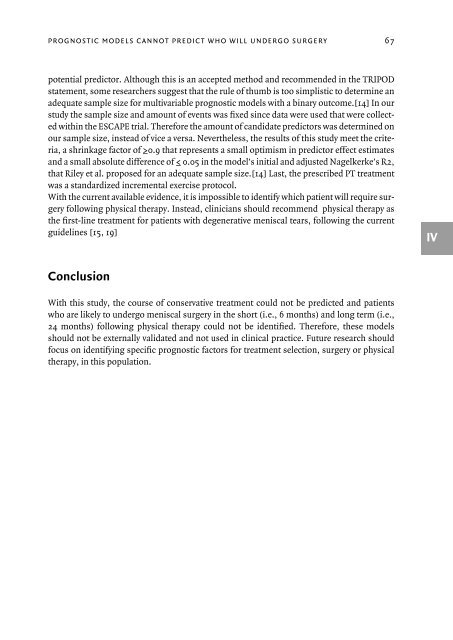Escaping the Scalpel
In-depth evidence to change clinical practice for patients with a degenerative meniscal tear. By Julia C.A. Noorduyn
In-depth evidence to change clinical practice for patients with a degenerative meniscal tear.
By Julia C.A. Noorduyn
Create successful ePaper yourself
Turn your PDF publications into a flip-book with our unique Google optimized e-Paper software.
PROGNOSTIC MODELS CANNOT PREDICT WHO WILL UNDERGO SURGERY67<br />
potential predictor. Although this is an accepted method and recommended in <strong>the</strong> TRIPOD<br />
statement, some researchers suggest that <strong>the</strong> rule of thumb is too simplistic to determine an<br />
adequate sample size for multivariable prognostic models with a binary outcome.[14] In our<br />
study <strong>the</strong> sample size and amount of events was fixed since data were used that were collected<br />
within <strong>the</strong> ESCAPE trial. Therefore <strong>the</strong> amount of candidate predictors was determined on<br />
our sample size, instead of vice a versa. Never<strong>the</strong>less, <strong>the</strong> results of this study meet <strong>the</strong> criteria,<br />
a shrinkage factor of ≥0.9 that represents a small optimism in predictor effect estimates<br />
and a small absolute difference of ≤ 0.05 in <strong>the</strong> model's initial and adjusted Nagelkerke's R2,<br />
that Riley et al. proposed for an adequate sample size.[14] Last, <strong>the</strong> prescribed PT treatment<br />
was a standardized incremental exercise protocol.<br />
With <strong>the</strong> current available evidence, it is impossible to identify which patient will require surgery<br />
following physical <strong>the</strong>rapy. Instead, clinicians should recommend physical <strong>the</strong>rapy as<br />
<strong>the</strong> first-line treatment for patients with degenerative meniscal tears, following <strong>the</strong> current<br />
guidelines [15, 19]<br />
IV<br />
Conclusion<br />
With this study, <strong>the</strong> course of conservative treatment could not be predicted and patients<br />
who are likely to undergo meniscal surgery in <strong>the</strong> short (i.e., 6 months) and long term (i.e.,<br />
24 months) following physical <strong>the</strong>rapy could not be identified. Therefore, <strong>the</strong>se models<br />
should not be externally validated and not used in clinical practice. Future research should<br />
focus on identifying specific prognostic factors for treatment selection, surgery or physical<br />
<strong>the</strong>rapy, in this population.
















